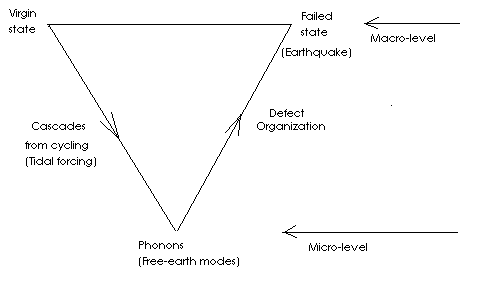
Some Generic Earthquake Physics
Randall D. Peters
Department of Physics
Mercer University
Macon, Georgia 31207
It is postulated that an earthquake has similarities to the process of crack
propagation in a metal, as it is cycled in stress to the point of failure.

The triangle shown above is due to Professor Thomas Erber of Illinois Tech University, who has done much work on this subject. Tom refers to the diagram (metal parts) as the phonon triangle. Its importance can be understood by considering how the bending of a coat hangar wire results first in a temperature rise within the wire and finally a fracture.
From the starting (virgin) macro-state of the wire, the path along the top of the triangle to the failed state is not possible; i.e., there clearly must be a path through the micro (atomic) level. The path shown--first cascades to the micro-level, followed by defect organization to the macro-failed point--is not possible in a linear system. In particular, the frequency up-conversion (from 1 Hz forcing) to 1012 Hz of phonons (temperature increase) requires nonlinearity in the form of defects. Similarly, the leg back up to the macro-level requires nonlinearity (unknown processes of defect organization). Although most physicists would recognize the leg going downward, very few people have given thought to the one going upward--the defect organization path.
It is postulated that the earth, on the megameter scale, is similar to the wire on the centimeter scale. Tidal forcing provides periodic stress in a manner that is analogous to the individual bending a wire. Cascades (internal to the earth) will result in free earth oscillations in a manner similar to the generation of phonons (quantized lattice vibrations) in the stressed metal. Thus, the free modes are expected to be intimately connected to the processes responsible for earthquakes. The study of low-level short lived eigenmodes (as opposed to the long-lived 'bell-ringers' of huge earthquakes) might yield insight into the cause for earthquakes--even perhaps ability at partial prediction.